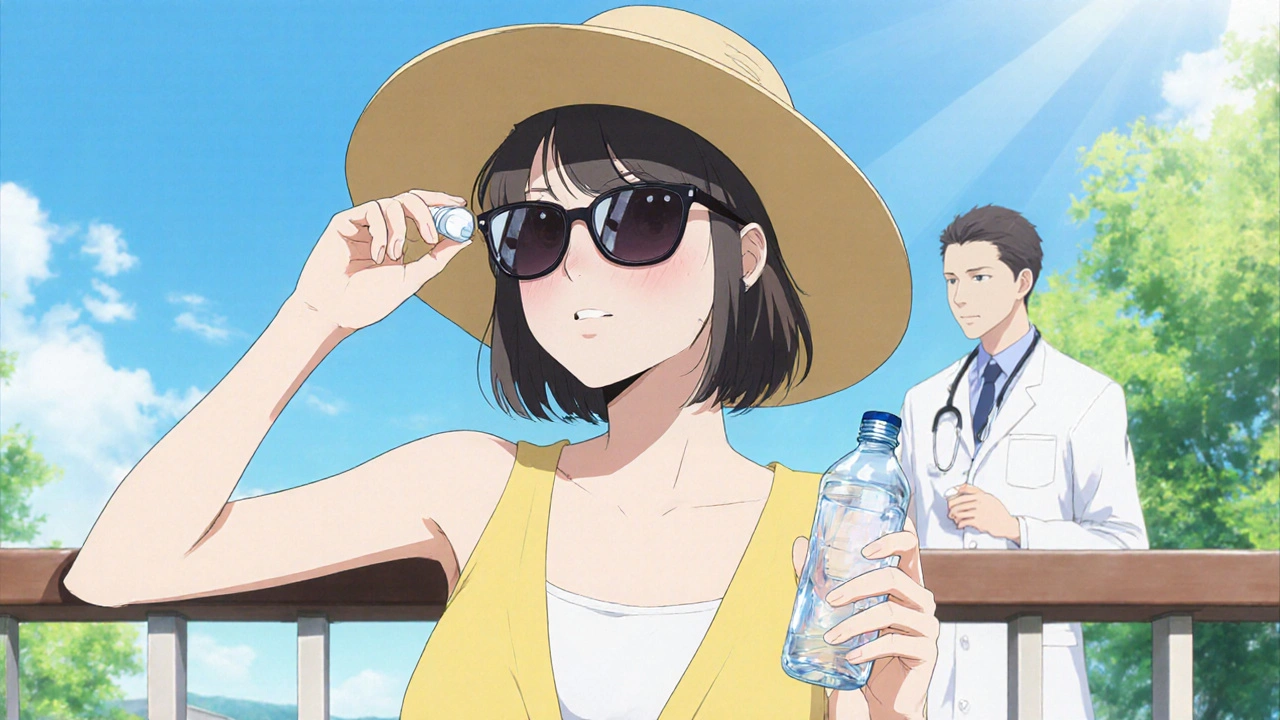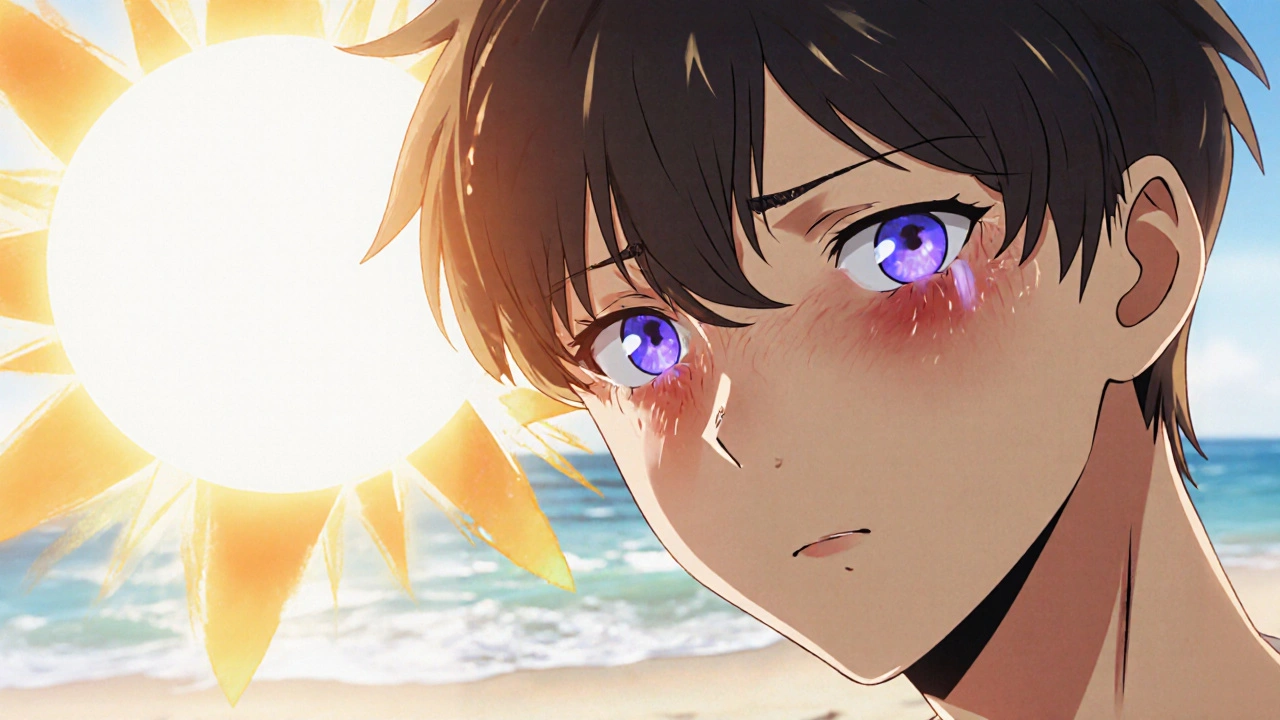Sunburn Eye Symptom Checker
Personalized Relief Guide
Enter your symptoms to get tailored recommendations based on medical guidelines.
Sunburn isn’t just about red, flaky skin - the delicate tissue around your eyes can swell, itch, and even blur your vision. If you’ve just spent a day under a blazing sky and woke up with puffy, tender eyes, you need quick, safe steps to calm the inflammation and protect your vision.
What actually happens to your eyes when you get sunburned?
Eye Swelling is a localized inflammation of the eyelid and conjunctival tissue caused by excessive ultraviolet (UV) exposure. The swelling results from blood vessels expanding and fluids leaking into surrounding tissues.
UV radiation damages the surface cells of the cornea and the thin skin of the eyelids. This condition is often called Photokeratitis, a sun‑burn of the eye that can trigger redness, tearing, and a gritty feeling.
Because the skin around the eyes is thinner than the rest of the face, it reacts faster and more intensely. The swelling can last from a few hours to a couple of days, depending on the severity of exposure and how quickly you act.
Step‑by‑step: Immediate relief actions
- Cool, not freezing, compresses: Soak a clean washcloth in cold (not ice‑cold) water, wring it out, and place it gently over closed eyelids for 5‑10 minutes. Repeat every hour for the first 4‑6 hours.
- Hydrate from the inside: Drink at least 2‑3 liters of water throughout the day. Proper hydration helps flush out inflammatory mediators.
- Avoid rubbing: Rubbing can worsen micro‑tears and push bacteria toward the eye, increasing infection risk.
- Artificial tears: Use preservative‑free lubricating drops (e.g., Artificial Tears) every 2‑3 hours to soothe irritation and flush out debris.
Home‑care remedies that actually work
- Cold compress with tea bags: Steep two green tea bags, let them cool, and place them on the eyes. The tannins act as a mild astringent, reducing fluid buildup.
- Cucumber slices: The water‑rich flesh delivers a soothing, cooling effect while providing a mild anti‑inflamatory boost from vitamin C.
- Aloe‑vera gel: Apply a thin layer of pure gel around (not inside) the eyelids. Aloe’s polysaccharides help calm skin inflammation.
All of these remedies are safe, inexpensive, and can be combined, but keep the skin dry and avoid any product that drips directly into the eye.

Over‑the‑counter (OTC) options
| Remedy | Key Ingredient | Typical Use | Pros | Cons |
|---|---|---|---|---|
| Cold compress (water) | Cold water | 5‑10 min, repeat hourly | Immediate soothing, no cost | Effect fades quickly |
| Artificial tears | Lubricating agents (polyethylene glycol) | 2‑3 ml every 2‑3 h | Reduces dryness, washes away debris | May need frequent re‑application |
| Oral antihistamine | Diphenhydramine or loratadine | 1 tablet once daily | Helps with allergic‑type swelling | Possible drowsiness |
| Corticosteroid eye drops | Prednisolone acetate | 1‑2 drops 4×/day (short‑term) | Powerful anti‑inflammatory | Requires prescription in many regions; risk of increased intra‑ocular pressure |
For most mild cases, the first three rows are sufficient. Reserve corticosteroid drops for severe inflammation and only under medical guidance.
When to seek professional help
- Vision becomes blurry or you see halos around lights.
- Severe pain, a feeling of a foreign body, or persistent burning after 24 hours.
- Signs of infection: increasing redness, pus, or fever.
- Pre‑existing eye conditions (glaucoma, dry‑eye syndrome) that could worsen with inflammation.
If any of these red flags appear, schedule an appointment with an ophthalmologist or visit an urgent‑care clinic. Early intervention can prevent corneal damage and lasting visual disturbances.

Long‑term prevention tips
- Wear UV‑blocking sunglasses (minimum 99% UVA/UVB protection) whenever you’re outdoors, even on cloudy days.
- Apply a broad‑spectrum SPF 30+ sunscreen to the eyelid skin, using a gentle, fragrance‑free formula.
- Wear a wide‑brimmed hat to reduce direct sunlight hitting the eyes.
- Stay hydrated and limit peak‑sun exposure (10 am‑4 pm) when the UV index is highest.
These habits not only protect against eye swelling but also lower the risk of long‑term conditions like cataracts and macular degeneration.
Quick reference checklist
- Cool compress (5‑10 min) ✅
- Hydrate - 2‑3 L water ✅
- Artificial tears every 2‑3 h ✅
- OTC antihistamine if swelling persists ✅
- Seek doctor if vision blurs, pain spikes, or infection signs appear ✅
Frequently Asked Questions
Can I use regular ice packs on my eyes?
Ice packs are too cold and can cause frostbite on the thin eyelid skin. Stick to cool (not freezing) water‑soaked cloths or chilled cucumber slices.
Do eye drops for allergies help with sunburn swelling?
Yes, antihistamine eye drops can reduce histamine‑driven swelling, but they won’t address the direct UV damage. Combine them with soothing compresses for best results.
Is it safe to wear contact lenses after a sun‑burned eye?
Avoid contacts until swelling and irritation subside. Contacts can trap debris and increase infection risk.
How long does sun‑related eye swelling usually last?
Mild cases improve within 12‑24 hours with home care. More severe inflammation may persist 48‑72 hours and benefit from OTC anti‑inflammatories.
Can sunscreen protect my eyelids?
A gentle, mineral‑based SPF 30+ lotion applied lightly to the eyelid rim can add protection, but be careful not to get it in the eye.


Deja Scott
October 20, 2025 AT 15:45Cool compresses work fast.
Natalie Morgan
October 21, 2025 AT 19:31Drink plenty of water and keep those eyes hydrated it helps flush out inflammation quickly. Use a cold, damp washcloth, not ice, for a soothing effect. Green tea bags are a cheap hack, the tannins calm the swelling. Remember to avoid rubbing – it only makes things worse.
Mahesh Upadhyay
October 22, 2025 AT 23:18Beware, neglecting sun‑burned eyes can lead to painful corneal damage and lasting vision loss.
Rajesh Myadam
October 24, 2025 AT 03:05I’ve seen cases where people ignored the swelling and ended up with a painful ulcer. A gentle cool compress combined with preservative‑free tears usually calms the inflammation within a few hours. If the pain persists, it’s wise to see an eye doctor sooner rather than later.
Andrew Hernandez
October 25, 2025 AT 06:51UV‑blocking sunglasses are non‑negotiable, they shield the delicate skin around your eyes and cut down on swelling.
Alex Pegg
October 26, 2025 AT 09:38All those home‑remedy tips sound nice but they’re just placebo; you need proper OTC antihistamines or a doctor’s prescription for real relief.
laura wood
October 27, 2025 AT 13:25I get that you want quick fixes, but a simple cucumber slice or chilled tea bag can truly reduce puffiness without chemicals. It’s worth trying before jumping straight to medication.
Kate McKay
October 28, 2025 AT 17:11When the sun scorches the skin around your eyes, the swelling can feel like a mini‑balloon pressing against your lids.
The first thing you should do is grab a clean washcloth, soak it in cool water, and place it gently over your closed eyes for about ten minutes.
This cool compress narrows the blood vessels and prevents fluid from leaking into the tissue.
Repeat the compress every hour for the first few hours – consistency is key.
While you’re doing that, start drinking water steadily; two to three liters a day keeps your body hydrated and helps flush out inflammatory chemicals.
Hydration also supports tear production, which is essential for washing away irritants.
In addition to water, use preservative‑free artificial tears every two to three hours; they lubricate the surface and clear out debris.
If you have some green tea bags on hand, steep them, let them cool, and then rest them on your eyes; the tannins act like a gentle astringent, pulling excess fluid away.
Cucumber slices are another classic – the high water content and vitamin C give a soothing, cooling effect that many people swear by.
For those who prefer a gel, a thin layer of pure aloe vera around the eyelids can calm the skin without getting into the eye itself.
Avoid rubbing your eyes because you can introduce bacteria and worsen micro‑tears.
If the swelling doesn’t improve after a day, consider an over‑the‑counter antihistamine tablet to reduce histamine‑driven puffiness.
Keep an eye on any signs of infection, like increasing redness, pus, or fever – those require a doctor’s visit immediately.
And remember, once the swelling subsides, protect your eyes with UV‑blocking sunglasses whenever you’re outside, even on cloudy days.
Making these habits part of your routine will not only speed up recovery but also help prevent future sun‑related eye damage.
Demetri Huyler
October 29, 2025 AT 20:58While your checklist is thorough, it breathes a bit of middle‑school science; seasoned eye‑care enthusiasts know that a balanced diet rich in omega‑3s can also mitigate inflammation from within.
JessicaAnn Sutton
October 31, 2025 AT 00:45Indeed, the inclusion of omega‑3 fatty acids, such as those found in fish oil, has been documented to reduce ocular surface inflammation, complementing the topical measures already outlined.
Israel Emory
November 1, 2025 AT 04:31All right, folks-let’s remember that a multi‑pronged approach works best; cool compresses, hydration, artificial tears, OTC antihistamines, and proper UV protection together form a comprehensive defense against sun‑induced eye swelling!!!
Sebastian Green
November 2, 2025 AT 08:18Thanks for summarizing; I’ll stick to the simple routine you listed.